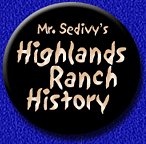|
Highlands Ranch High School - Mr. Sedivy
Highlands Ranch, Colorado

- Colorado History -
The The Gratlan Affair / Massacre
Fort Laramie
The Gratlan Affair
In August 1854, a series of incidents occurred that would result in
a massacre at Fort Laramie, Wyoming. A Mormon comes in and states
that he was sure that the Indians are his cow. A Lakota chief, Bear
That Scatters, came to the fort to pay for a cow that the Indians
had to put out of its misery. He offered $10, but the Mormon wanted
$25. This was unreasonable, so the chief went back home.
Second-Lieutenant Gratlan was in charge. Gratlan, twenty-nine
men, two cannons, and a drunken French interpreter set off. They stopped
at another fort on the way, but the owner Boraux didn't want to go
with. Gratlan gets to the village and says, "The $25, or the cow killers."
The warrior would not surrender, afraid of white jail and torture.
A nervous soldier fired the first shot hitting Bear That Scatters.
The Lakotas warned the soldiers. The Indians kicked butt.

A lurid portrayal of the Minnesota Massacre by John
Stevens.
Left: An Indian squaw cuts the legs of a captive white girl, Julia
Smith. Right: Julia tries to protect her mother from being shot, but
both were killed by the same bullet.
Massacre at Fort Laramie
After the Gratlan Massacre, the Cheyenne headed for Fort Laramie.
But, en route they saw Bordoux out front of his trading post tossing
goods out the door - This stopped the Indians. As he was dying, Bear
That Scatters pleaded that they not avenge him. So, the Cheyenne attacked
a wagon train - this was their retribution.

Fort Laramie, in the heart of Sioux territory, became
an army post in 1849.
Tom Twist, an Indian agent, arrives. He asked the Lakota
to move away from the North Platte and the white men. All the Cheyenne
left, except one tribe. They didn't feel that they had to leave, as
they didn't do anything wrong. This will lead to another massacre
at Ash Hollow.
Fort Laramie Treaty - 1851
Thomas Fitzpatrick, Indian agent was urging the US Federal Government
to make a treaty for the plains. In the summer of 1851, the government
called for a treaty to establish boundaries and rights for the Plains
tribes. They would meet at Fort Laramie, Wyoming This was called the
Fort Laramie Treaty, also known as the Horse Creek Treaty (where the
Indians camped), or the Fitzpatrick Treaty.

Interior of Fort Laramie painted by Alfred Jacob Miller
in 1837.
Every Plains tribe was invited. Most came, but not the
Pawnee, the Kiowa, or the Commankae. All-out war almost started between
the tribes while they were waiting for the government to arrive. One
provision of the treaty was that all tribes signing pledged peace
with each other. The government was trying to make peace between the
tribes.
The treaty gave specific territory to the Indians for
as long as the winds blew. The Cheyenne, and Arapaho with Smith as
interpreter, received 122,000 square miles - from the continental
divide to the North Platte (Nebraska), straight down to the Arkansas
River back to the Platte.
The Indians were given Colorado because of Pike's and
Long's reports:
"Leave the desert and paounta to the
Indians."
The Indians were to receive 50,000 for fifty years so
that the whites could establish roads, "military and otherwise," across
Indian lands. The Indians made their mark and the treaty went to the
Senate where it was amended to 15 years. Now it would have to be resigned
to be valid. Fitzpatrick would need lots of luck to get these marks.
The Cheyenne Arapaho had a big problem, and none of the Pawnee signed.
This will lead to more intertribal wars.
Treaty of Fort Laramie - 1868
Peace commissioners including Generals William S. Harney
and William Tecumseh Sherman came west in 1868 to seek an end to hostilities
with the Cheyenne and the Lakota. Among the Indian leader attending
were Spotted Tail, Brule Lakota; Roman Nose, Cheyenne; and Man Afraid
of His Horses, Oglala Lakota.
 
Left: General William Harney (white beard) and William
Tecumseh Sherman at Fort Laramie.
Right: Man Afraid of His Horses smoking a ceremonial pipe.

Treaty of Fort Laramie in May 1868. Among the Indian
signers was the Sioux chief Man Afraid of His Horses (second from
right) and Red Cloud who signed in November.
Back to the top of page
- Colorado History In Depth
-
Lecture Notes, Reading, and Information:
| The Cheyenne Migration
to Colorado |
| The Gratlan Affair, Massacre, Fort Laramie
Treaty |
The Cheyenne Social Club
| A Cheyenne War Story: Wolf Road, the Runner
|
| Cheyenne Traditions and Beliefs, Sacred
Stories |
| Horses, Warriors, War Pipe, Sweatlodge
Ceremony |
| Cheyenne War Parties and Battle Tactics
|
| The Scalp Dance and Other Cheyenne Dances
|
Fort Union
| The Sante Fe Trail and Fort Union |
| Sumner - Ninth Military Department / The
First Fort Union |
| Early Arrivals to Fort Union, Daily Life
at Fort Union |
| Captain Grover - The New Fort Union, the
Confederate Threat |
| Fort Union Arsenal, William Shoemaker,
End of Fort Union |
Americans from the East
| Thomas Jefferson, the Louisiana Purchase
|
| The Expedition of Zebulon Pike |
| Pikes Peak or Bust / Colorado Gold Rush
|
Colorado's Role in the US Civil
War
| The Civil War, Fort Wise / Fort Lyon
|
| Mace's Hole, Colonel Canby, F.C.V.R.
| Fort Weld |
| The Pet Lambs, John Chivington |
| General Henry Sibly, Battle of Valverde,
Fort Union |
Cripple Creek District Labor Strikes
| The Western Federation of Miners / State
Militia |
| The 1893 - 1894 Strike | The
Strike of 1903 - 1904 |
| The Mine Owners Association |
| Crimes and Military Rule in the Cripple
Creek District |
| Marshall Law in Cripple Creek District
/ End of the Strike |
Early Cripple Creek District
| Photos, Fire, and Life in Cripple Creek
|
| Other Colorful Towns in the Cripple Creek
District:
Gillett - Colorado's Only Bullfight, Victor, Independence |
| A Guide to the Miners' Gritty Lingo
|
More Colorado History
Information
| Bent's Fort Photos, Personalities, Plans,
and More |
| What Was Easter Like at Bent's Fort?
|
| Colorado Trivia,
Miscellaneous Old Photos,
Western Personalities, Forts, and More |
| Lullabies for Jittery Cows - Cowboy Ballads
|
| Heraldry of the Branding Iron |
| Project
Aims to Clear Infamous Cannibal, Alferd Packer |
| Lead Gives Alferd
Packer's Story More Weight |
| Legendary
Colorado Love Stories: Baby Doe Tabor & More
|
| Colorado Pioneer Women: Elizabeth Byers
|
| Early Denver Jokes / The History of April
Fools' Day |
Back to the top of page
|



![]() 9375 South Cresthill Lane
9375 South Cresthill Lane ![]() Highlands Ranch, Colorado 80126
Highlands Ranch, Colorado 80126 ![]() 303-471-7000
303-471-7000






